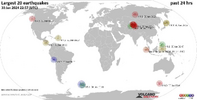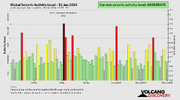M 5.1 - 257 km SW of Merizo Village, Guam
- 2024-02-01 07:45:39 (UTC)
- 11.845°N 142.792°E
- 10.0 km depth
The total number of earthquakes recorded worldwide in the last 24 hours has increased to 1103 which is above normal activity. This was mainly due to the seismic swarm that is happening in Hawaii, especially in the Kilauea volcano.
444 earthquakes at Kilauea over the last 24hrs and still no eruption....
Recent Systemic Activity in
Austria
The earthquake-filled weeks in Austria continue. After several earthquakes in Tyrol, a powerful earthquake shook the east of the country last night. It reached a magnitude of 4.4 and was felt as far away as the Czech Republic and Slovenia.
https://erdbebennews.de/2024/02/erdbeben-m4-4-nahe-gloggnitz-oesterreich/
Snip:
People affected
The 4.4 earthquake occurred on 1 January February, 2:59 Clock Central European Time near the village of Gloggnitz, Austria. Earthquake news calculates a maximum intensity of 5.6 for this earthquake. Up to 7.5 million people (in the map section) have felt this earthquake. Of this, 7.5 million people live in regions with light or moderate shocks, where no significant
damage is to be expected. 0 people live where damage to buildings may occur, 0 of them in areas with possible severe damage and destruction.
What happened?
The epicenter was located near the town of Gloggnitz in Lower Austria on the border with Styria.
After initial evaluations by Geosphere Austria, the earth magnitude 4.4 reached the earth. Shocks were felt throughout the eastern half of the country and included not only the epicentre route, but also the capital of Vienna (intensity III), Graz (intensity III) and Linz (intensity II). In addition, the earth also reached parts of the neighbouring countries Slovakia, Hungary and Slovenia. Occasionally it could have been felt in the south of the Czech Republic, possibly also locally in Lower Bavaria. Previous earthquakes in the region showed relatively far-reaching effects towards Lower Bavaria.
In the epicentral region between Semmering and Gloggnitz, the vibrations were quite strong due to the shallow depth and, according to our calculations, lie between intensity V and VI, so that even minor structural damage to individual buildings cannot be ruled out. Smaller stone chips and avalanches are possible in the mountains. In addition, high post-quake activity must be expected in the coming days.
In recent years, Gloggnitz has been one of the most importantly active places in Austria with numerous noticeable quakes, partly around magnitude 4, as well as numerous swarms of smaller earthquakes. The village is located on the Mur-Mürztal disorder, a tectonic fault zone in the northeastern Alps, where earthquake activity is often occurred.
After numerous earthquakes in Tyrol, today's earthquake has been the strongest of a seismicly very active phase in the last three weeks. Previously it came on the 27th place January in
Ehrwald in Tirol to a earthquake of magnitude 3.6 and in the days before several noticeable quears up to magnitude 3.9 in St. Johann in Tirol. In both regions, there were smaller, non-structural damage to houses as a result of the vibrations. In addition, adjacent places in Bavaria were also affected by the earthquake.
Between the individual earthquakes in Ehrwald, St. Johann and now in Gloggnitz there is no direct connection. The accumulation of seismic activity since the beginning of the year is a random overlap of several independent events.
Kilauea earthquakes ramp up.
 CALIFORNIA VOLCANO OBSERVATORY WEEKLY UPDATE
CALIFORNIA VOLCANO OBSERVATORY WEEKLY UPDATE
U.S. Geological Survey
Tuesday, January 30, 2024, 3:07 PM PST (Tuesday, January 30, 2024, 23:07 UTC)
Monitored CALIFORNIA VOLCANOES
Current Volcano Alert Level: all NORMAL
Current Aviation Color Code: all GREEN
Activity Update: All volcanoes monitored by CalVO show normal background earthquake activity and ground movement. Monitored volcanoes include Mount Shasta, Medicine Lake Volcano, Lassen Volcanic Center, Clear Lake Volcanic Field, Long Valley Volcanic Region, Coso Volcanic Field, Ubehebe Craters, and Salton Buttes.
Past Week Observations for January 22, 2024 (0000h PST) through January 28, 2024 (2359h PST):
Three earthquakes greater than M1 were recorded near Lassen Volcanic Center, with the largest having a magnitude of M2.3.
One earthquake greater than M1 was recorded within the Clear Lake Volcanic Field, with a magnitude of M1.2. Typical seismicity was recorded at the Geysers geothermal field south of the Clear Lake Volcanic Field; 120 earthquakes greater than M1 were recorded, with the largest having a magnitude of M4.2.
One earthquake greater than M1 was recorded in Long Valley with a magnitude of M1.0. Six earthquakes greater than M1 were recorded in the Sierra Nevada Block, south of Mammoth Mountain and Long Valley, with the largest having a magnitude of M2.3. One earthquake greater than M1 was recorded at Mammoth Mountain with a magnitude of M2.4.
Five earthquakes greater than M1 were recorded in the Coso Volcanic Field, with the largest having a magnitude of M1.9.
Six earthquakes were recorded at the Salton Buttes, with the largest having a magnitude of M2.6.








